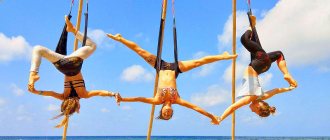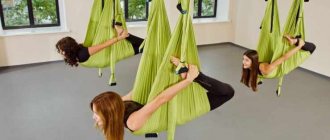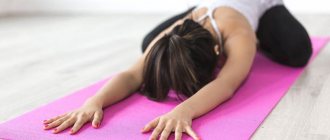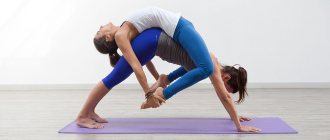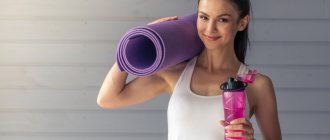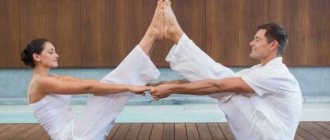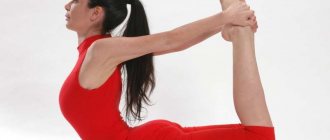Fly yoga is one of the ways to stay fit and fight stress. The traditional practice of asanas is beneficial for the soul and body, while fly fitness has a number of advantages: working in a hammock relieves stress on the joints, develops pulmonary, diaphragmatic breathing, improves flexibility, and helps burn more calories. But in order for the practice of aerial exercises to bring only benefits to the body, it is necessary to do it correctly.
Fly yoga is a combined type of training that combines elements of gymnastics, Pilates and traditional yoga. They perform exercises suspended above the ground using specific equipment: hammocks, hoops, fabrics, belts, trapezoids.
| Aspects of transformation | The essence of transformation |
| Health | Body: Fly yoga for weight loss improves physical fitness. Focus on energy-intensive exercises that develop strength. Fly yoga for beginners develops flexibility, endurance, and prepares the body for complex asanas. Spirit: the state of flight promotes meditative practices, clears the mind of stress, relieves physical tension, and promotes complete relaxation. |
| Thinking | Fly yoga in a daily schedule forms stable neural connections, stimulates the production of endorphins, and develops healthy thinking. By regularly practicing aerial asanas, you can “turn” your consciousness, look at things differently, and develop unconventional thinking. |
| Determination | Yoga philosophy focuses on the end goal. It helps to cultivate “tapas” (determination) - the vitality and energy necessary to achieve your goals. |
Benefits and harms
pros
- Relieves tension from the spine.
- You can refuse sedatives, because yoga on canvas has a relaxing and calming effect.
- Improves stretching, agility, flexibility.
- Trains the vestibular apparatus.
- Suitable for those who do not want to wait a long time for results: surprisingly, the effect is visible literally after a few workouts.
- Reduces the load on your legs, so you no longer have to worry about varicose veins!
- It has a positive effect on posture: often, after several workouts in hammocks, a person can gain up to 1.5 cm in height!
Despite the fact that aerial yoga is a relatively new trend, almost all reviews are positive.
It is interesting that this practice has practically no disadvantages, and those that exist are mainly associated with contraindications.
What is the essence of the direction?
Aerial yoga, Antigravity and aerial yoga are the names of a set of exercises performed in a hanging hammock. It is a special swing with loops for arms and legs, attached to the ceiling. The material from which they are made is very durable and can withstand up to 180 kg of live weight. Work with increasing height is carried out gradually, starting from 30 cm and up to 1 m. For safety, insurance is provided under the swing.
The exercise routine includes elements from other areas of fitness, including:
- yoga;
- acrobatics;
- callanetics;
- stretching;
- Pilates.
Difficulty levels vary depending on the person’s preparation; even a beginner can begin to practice Antigravity. The advantages of aerial yoga include the novelty of emotions, which is different from other sports.
The main feature of fitness in a hammock is that it takes on part of the weight, making turns, asanas and stretching much easier. This relaxes the muscles and releases pressure from the joints. As a result, the body becomes not only strong, but also flexible and well-stretched.
Contraindications
Before going to yoga classes in hammocks, you need to familiarize yourself with the list of contraindications, and even better, consult with your doctor to avoid injury.
- Full stomach. Carefully! Exercise in this case can lead to nausea and even vomiting!
- Hard physical work.
- Mental disorders.
- Spinal injuries.
- Glaucoma.
- Severe traumatic brain injury.
- Heat.
- Malignant neoplasm.
- Blood diseases.
There are also so-called temporary contraindications, which prohibit exercise in hammocks only for a certain period. These include:
- exacerbation of chronic diseases;
- taking a large number of medications;
- postoperative recovery;
- elevated temperature;
- 6-8 hours before and 4 hours after visiting the sauna;
- period of painful menstruation in women.
We answer questions
What to wear to class?
For asanas in hammocks, comfortable, elastic clothing without decorations, zippers, or sharp parts (to avoid snagging on the fabric) would be suitable. It is better if the suit is tight-fitting and completely covers the body (this will make it easier to slide along the canvas). Alternatively, use wrist pads, leggings that cover your ankles, or tight t-shirts with sleeves that cover your armpits.
How to choose an instructor?
The purpose of practice is not only physical development, but also spiritual development. The instructor (or teacher) should suit you in terms of temperament, pace, and level of preparation. He should share his experience, and not implant his ideas, help you relax, and not irritate. Only in this way will it be comfortable to get to know yourself, as well as master the culture of anti-gravity practice.
Is it possible to study on your own?
If your level of training allows you to practice on your own, then you can learn new asanas using video lessons. Here are some options for inspiration:
How is the lesson going?
The load is selected individually by an experienced trainer, so there is no need to worry that it will be too difficult or, conversely, very simple.
First, several pranayamas are performed while swinging in a hammock. This way, you can concentrate on your practice and get rid of all extraneous and negative thoughts and attitudes. After warming up, you can begin more intense exercise - first on the floor, but using a hammock, and then completely in it.
Inverted asanas are considered the most pleasant, because it is after them that both physical and emotional state improves. However, the main condition to get the expected result is a completely relaxed body. Otherwise, unpleasant consequences such as dizziness or even nausea cannot be avoided.
And the antigravity yoga session ends with the so-called “dead pose” or shavasana, the result of which will be complete relaxation.
What are the benefits of fly yoga?
Fly yoga is suitable for both beginners and experienced athletes. Let's highlight 5 main advantages over other sports:
- Spinal traction. A hammock helps eliminate discomfort in the spine that occurs due to gravity and relieves stress on the vertebrae and joints. To keep the body suspended or in an inverted state, stabilizer muscles are activated and the muscular frame that supports the spine is strengthened.
- Development of breathing. When performing asanas, special attention is paid to correct, controlled breathing. This develops the functional volume of the lungs and diaphragmatic breathing, increases the level of blood oxygen saturation, and stimulates the functioning of the lymphatic system.
- Improved flexibility. A flexible body gives you more mobility in everyday life and develops skills for performing more complex asanas.
- Antistress. Inversion poses stimulate blood flow to the head, saturate the brain with oxygen, help eliminate stress, and energize.
- There is no “overtraining” effect. The advantage of fly fitness is that even with daily training, the body does not stiffen. The main thing is to listen to your personal feelings and inner state.
Types of hammocks
To achieve the desired result, it is very important to choose the right hammock. They come in two types:
- fabric folded in two layers;
- with additional accessories such as handles, inserts and stirrups for hands.
To perform some complex asanas, auxiliary devices, as well as soft inserts that are equipped with some hammocks, will be of great help. With their help, the fabric puts less pressure on the body during training, which makes the practice even more comfortable.
Yoga in hammocks - exercises
Traditionally, a fly yoga class lasts about an hour and consists of several stages:
- First, a person must normalize breathing and completely control it.
- After this, a light warm-up is carried out, which includes turning the head and bending.
- At the third stage, you can begin to perform simple exercises from the complex that fly yoga offers, performed both with and without a hammock.
- After this, you can move on to “aerial” exercises, in which a complete lift off the floor occurs and the person begins to soar.
- Only experienced people can proceed to the last stage, since it involves performing “inverted asanas.”
There are a huge number of exercises used in hammock yoga, and many of them are taken from regular yoga. An example is the most popular movements.
- Place the hammock under the bottom edge of your shoulder blades. Straighten your arms and clasp your feet with them. Move forward by standing on your toes and arching your body, which should resemble a sail. More advanced athletes can lift their feet off the ground and perform the exercise in the air (Figure 1). The opposite, that is, compensatory exercise, is the “child’s pose”, for which you kneel down, clasp your hands around the hammock and bend your back (Fig. 2).
- The next exercise is called the “Greek runner”, to perform which place one leg, bent at the knee, on a hammock, and the other rest on the floor (it should be straight). Tilt your body back and point your knee on the hammock forward. Repeat everything on the other leg.
- Many people like yoga in hammocks as a “flight” exercise. Straighten the hammock and position yourself so that your lower abdomen and thighs are on it. Having found your balance, grab the hammock with your hands and make a slight arch in your lower back. Hold for half a minute and relax. Repeat several times.
Preparing for the first training session
In order to avoid discomfort, you need to choose the right clothes. Ideally, it will be a comfortable top or T-shirt and leggings made of elastic fabric. It is very important that there is no tugging or stinging anywhere, otherwise it will be quite difficult to relax and concentrate on practice.
Often, before the first training session, people worry that the trainer will immediately give them a load that they simply cannot handle. But there is no need to worry about this, because beginners will never be asked to perform complex asanas, and they will also tell you in detail how to use the hammock. In addition, the first training sessions are devoted exclusively to breathing techniques and the ability to maintain balance.
To summarize, fly yoga is not only useful, but also an enjoyable practice that will help even the most stressed person relax and feel much better both physically and emotionally.
For whom is fly-yoga contraindicated?
Fly yoga, the benefits of which are undeniable, still has a number of contraindications. You should not practice air elements:
- pregnant women;
- people with heart disease, glaucoma, arthritis, atherosclerosis, varicose veins, thyroid diseases;
- hypertensive and hypotensive patients;
- during the rehabilitation period after surgery;
- those who suffer from dizziness, have problems with balance, are afraid of heights;
- people with musculoskeletal disorders.
Basic exercises
Aero yoga includes about 300 varieties of asanas and exercises. It includes a symbiosis of classical oriental knowledge, fitness, acrobatic and gymnastic elements. This combination helps to achieve good results in a short time.
The training program is developed by the trainer taking into account the characteristics of the person, the chosen direction and the desired result. Movements can be performed with support on the floor surface or without touching it.
Inverted asanas (head down) become important in Aeroyoga. To perform such exercises, you need to practice. You should switch to such asanas only after 2-3 preparatory classes.
What should I do if I’m just not losing weight?
There are people who don't lose weight no matter what they do, who have to put up with endless pressure on every extra kilo on the scale - and then, when they start eating normally again, they immediately gain 20 more kilos on their thighs. If you are one of those people, if you have countless diets, detoxes, exercises and diet pills under your belt, then let go.
If you want to be happy and not torment yourself for the rest of your life, then stop wondering what you are doing wrong, like eating less, how to exercise more. Stop defining yourself by your figure, by your appearance. Stop reading women's magazines and diet books. What others say about you doesn't matter, and neither does the current ideal of beauty. You are beautiful, you are beautiful and you can be exactly who you are. You can enjoy it, you can love sweets and creamy noodles, you can snuggle up on the couch after work.
Because let's be honest, neither your love happiness nor your career depends on the number on your scale (which you please throw away right now). The way you look makes you completely pessimistic about everything that is important in this life. And in case of doubt, it will also be better for your health if you weigh 20 kg more and spend your life happy and relaxed, instead of treating yourself pointlessly throughout your life - schedule and registration: Yoga studio Vladimirskaya Yoga center Sampsonievsky
What is antigravity yoga?
Antigravity yoga is a relatively new fitness program, which is characterized by a combination of various fitness techniques and styles borrowed from other areas.
What techniques and styles does anti-gravity fitness combine?
The most varied! For example:
- static yoga asanas;
- dynamic vinyasas;
- Pilates elements;
- strength exercises.
But its main feature, as we have already mentioned, is the use of various additional equipment.
Warm-up
Exercise 1
- Stand up straight. Greeting Namaste.
- As you inhale, raise your arms up and stretch into a string. As you exhale, lower your arms straight down to your sides.
- Repeat 4 times, filling your body with breath.
Exercise 2
- Place your feet shoulder-width apart. Bend your arms at the elbows and place them on your waist.
- Roll from your toes to your heels.
- Repeat 5 times.
- Raise your bent right leg up, arms to the sides.
- Rotate your feet and hands at the same time, imagining that you are winding a thread (10-20 sec).
- Repeat for the other leg.
What it is?
What is another name for yoga in hammocks? You may come across names such as fly yoga, aerial yoga or anti-gravity yoga. To perform asanas you need air space.
Some of the exercises are borrowed from acrobatics, Pilates, and gymnastics. This is a symbiosis of spiritual practice and sports.
The anti-gravity direction also differs from traditional yoga in that all asanas are performed in hammocks, which are suspended from the ceiling. This is a relatively young movement in Russia, rapidly gaining popularity. Those who practice fly yoga note positive dynamics, decreased stress levels and improved physical fitness.
Indications
This practice has a healing effect if:
- Problems with the spine, including osteochondrosis, scoliosis, lordosis, kyphosis, herniated discs.
- Arthritis and arthrosis of the joints.
- Chronic fatigue syndrome.
- Anxiety.
- Insomnia and poor sleep.
- Persistent internal tension.
- Psychosomatic consequences of long-term stress.
- Asthenia.
- Vegetovascular dystonia.
- Functional disorders of internal organs.
- Chronic problems with internal organs.
- Decrease in general physical indicators: muscle hypotonicity, lack of stretching and flexibility, muscle tension, underdeveloped vestibular apparatus.
Can I lose weight with yoga?
Yes! Some people still think that yoga is a pure relaxation technique and therefore not suitable for weight loss. Yoga places a lot of emphasis on relaxation, but with most styles you actually experience some serious physical challenge - on many levels.
Because yoga is much more than just physical exercise. Next, we'll explain how yoga helps you lose weight and which yoga styles and exercises can help you lose weight. You'll also learn why a yogic detox helps you lose weight, how yoga relaxation exercises affect your weight, and how yoga frees you from destructive beauty ideals and allows you to accept your body as it is.
Lose weight with Vinyasa Flow Yoga
Like other sports (yes, yoga is a sport too - or at least it can be), the more calories you burn, the more excited you are, the higher your metabolism, the more muscle you build. So, if you continue to eat the way you have been, at some point you will lose weight with yoga—even yogis don't need a calculator to come to that conclusion.
The best yoga styles for weight loss Yoga styles that are practiced dynamically are best for weight loss, in other words: in which you are constantly in motion, that is, you do not perform individual asanas for a long time, as in classical hatha yoga. These styles of yoga are often called “vinyasa flow” (vinyasa = meaningful sequence = flow).
The following yoga styles deserve special attention:
- Ashtanga Yoga When it comes to working the body, Ashtanga Yoga can't be beat. In classical Ashtanga, you practice independently, but regularly under the watchful eye of a teacher, a steady sequence of challenging yoga exercises. With each inhalation you perform a certain movement and thus remain in motion - in concrete terms: in the flow. It requires a lot of internal and external discipline and is very tiring. If you practice daily (or almost daily), as is customary in Ashtanga yoga, you will notice serious changes in your body within a few weeks. And after just a few months, you will hardly be able to believe how much your figure has changed.
- Power Yoga/Vinyasa Yoga. Power yoga or Vinyasa yoga is a modern style of yoga that is based on Ashtanga yoga but taught in a completely normal form. Most of the exercises are taken from Ashtanga Yoga, but the focus is on asanas that are fairly easy to perform, require a lot of effort, and have a strong activating and strengthening effect. Here too you are practicing in flow, and here movement and breathing are in harmony.
- Jivamukti Yoga Jivamukti Yoga was invented by a couple of yoga teachers from New York, Sharon Gannon and David Life. To the accompaniment of loud music, you perform complex sequences of asanas with elements of yoga-style dance in a Vinyasa flow popular among the townspeople. Jivamukti yogis also promote a vegan lifestyle (which, by the way, is very good for weight loss).
- Spiritual Yoga, a style of spiritual yoga developed by renowned Berlin yoga teacher Patricia Thielemann, is also ideal for building muscle and losing weight:
Detoxification as the basis for weight loss.
Let's get back to the amazing yoga techniques that can help you lose weight. There are nutritionists who say that the body will only allow weight loss if there are not too many toxins in it. On the one hand, this is due to the fact that a slagged organism is usually associated with the intestinal mucosa. However, if your gut cannot optimally extract nutrients from food, your body will lack nutrients, even if you theoretically provide yourself with more than enough nutrients. This is why your body then "tells" you to eat more...
Another aspect: when you lose weight, the body attacks your fat deposits and dissolves them. The body also stores toxins in fat that it cannot remove from the body, which is how it detoxifies them in the first place. Dissolved fat deposits release toxins during dieting, so your body has to deal with a dangerous flood of toxins while dieting (which is why sick and pregnant women should not diet or fast). Therefore, with strict diets and fasting, you often develop bad breath and body odor - the body then removes the released toxins through the breath and through the skin. However, if your body has previously had a hard time dealing with massive amounts of toxins, it can't break down and eliminate excess toxins quickly enough - so it may (wisely!) refuse to attack fat deposits and the pounds on your scale stagnate.
Fortunately, yoga has a strong detoxifying effect: physical exercise (asanas) not only stimulates metabolism and digestion and improves blood circulation, which improves and speeds up the elimination of toxins, but also helps the body, along with relaxation exercises and deep breathing. To break down stress hormones, which are toxic to the body in large quantities. Yoga rids your body of toxins and ensures that you finally succeed in losing weight.
